Map: Where agricultural engines are made
Turn the key and – all being well – it fires up ready for another day’s work on the farm. But who makes the engines used in agricultural vehicles, and where are they built?
There was a time when Cummins, Deutz and Perkins dominated the production of diesel engines for tractors, loaders, sprayers and self-propelled harvesters. But times change: technical challenges, company strategies and production economics have brought more engine makers into the field.
Below we chart the source of power for agricultural machines used in the UK.
See also: Buying a tractor? How to make sense of engine statistics
Agco Power
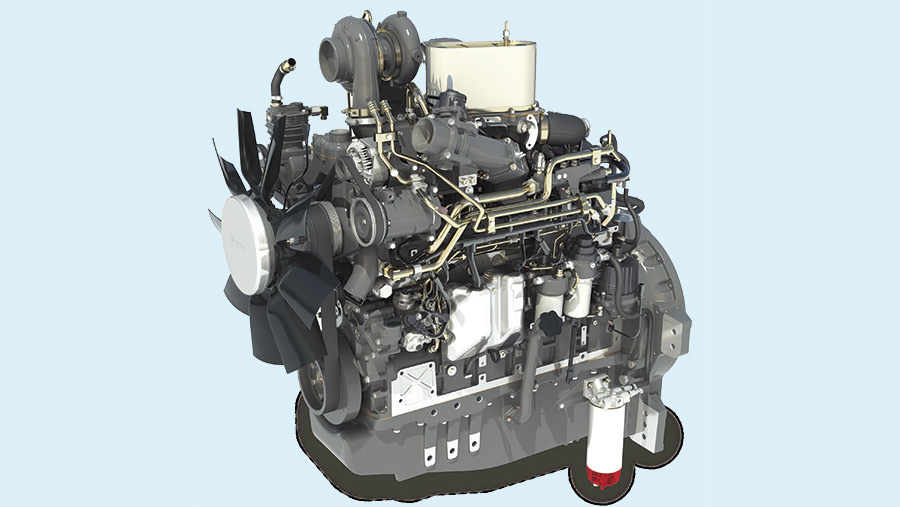
Agco Power 8.4-litre diesel, as used in the Massey Ferguson 8400 S Dyna-VT range
When Agco bought the Valmet (now Valtra) tractor business in 2004, Sisu (now Agco Power) engines came as part of the package.
Investment in engineering and assembly at the Linnavuori plant in Finland – to increase capacity to 50,000 units a year – led to the engines being progressively introduced into the entire Massey Ferguson tractor and combine ranges, with four-, six-, seven- and 12-cylinder designs.
The 3.3-litre and 4.4-litre diesels have more recently been introduced to the Fendt 200 Vario and 300 Vario tractors, the 9.8-litre and 16.8-litre designs replaced Cat units in the Challenger (now Fendt in Europe) tracked tractors, and the principal OEM customer in agriculture is JCB for its Fastrac tractors.
Agco Power also makes engines in Argentina (3,000 units capacity) and Brazil (30,000 units), and also in China (30,000 units) for the Global Series tractors built there.
Caterpillar
Cat’s influence has diminished in the agricultural market for large US-built six-cylinder engines but it retains a presence through the Perkins-branded Cat engines used by Claas in the Avero and Lexion 760 combines.
Cat’s own telehandlers are powered by engines built in the Perkins plant in Peterborough.
Cummins
At its Darlington plant on Teesside, Cummins makes QSB diesels, which JCB installs in wheeled loaders and Bargam uses in its Italian-built sprayers, with Agrifac switching from Volvo to 9.6-litre Cummins power with up to 420hp for the next-generation Condor Endurance sprayer.
Canada’s Versatile is the main tractor customer. Its range is powered entirely by Cummins, while John Deere uses the 15-litre QSX15 in the two most powerful models in its 9R/RT/RX line-up.
The 4.5-litre and 6.7-litre engines are ultimately derived from the European Engine Alliance joint venture with New Holland and Iveco Trucks, which was dissolved in 2008 when Fiat Group’s FPT Industrial assumed full ownership of the Turin factory built to produce the new power units.
Cummins likewise gained full control of the Rocky Mount Plant in North Carolina, originally set up with Case Corporation as Consolidated Diesel Corporation (CDC).
Daedong
The South Korean manufacturer makes most of the engines installed in its Kioti tractors but it recently signed a multi-year deal with Doosan.
Deutz
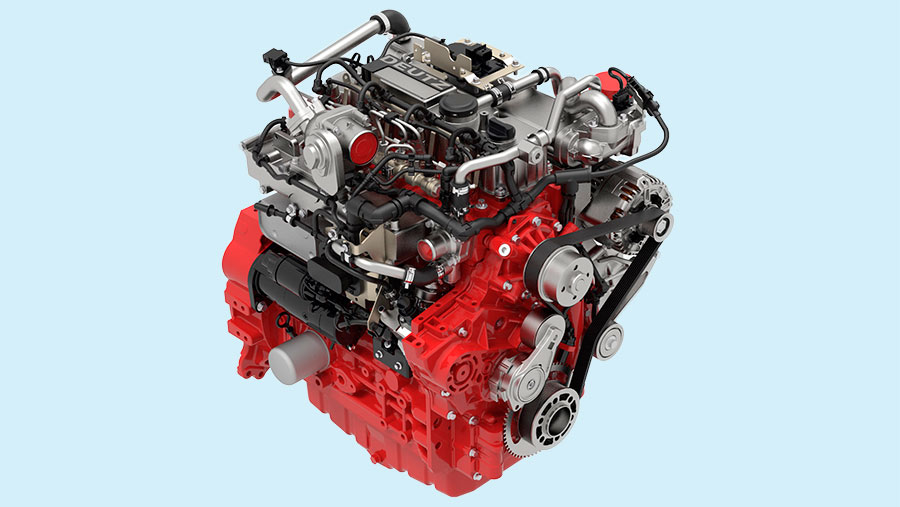
Deutz TCD3.6 compact four-cylinder engine is used in tractor and handler application
This is the independent engine brand found most commonly powering farm tractors and equipment. In 2017 the German manufacturer supplied 21,660 diesels to agricultural vehicle manufacturers (up 26% on the year before) out of a total of 161,646 units.
Apart from fulfilling the bulk of SDF Group’s engine needs for Deutz-Fahr and Same tractors, the Cologne-built diesels are used in Fendt Vario tractors from 130hp to 396hp.
Argo Tractors is a more recent customer, switching to new compact Deutz engines for its 70-136hp Landini and McCormick models, and Zetor also now uses the engines for the small Hortus and Major and the six-cylinder Crystal models.
Deutz powers the Chafer Interceptor, Hardi Alpha and all Sands sprayers with TCD6.1 engines, and a raft of telescopic handlers from Claas, Faresin, Kramer, Manitou and Merlo as well as wheeled loaders from Schaffer, Tobroco and Weidemann rely on Deutz power.
Engine manufacture for local markets is undertaken in Argentina in co-operation with Agco, and at a joint venture in China.
Doosan
This South Korean construction machinery giant, which counts Bobcat among its divisions, is no stranger to building large diesels for marine and other applications but it is a relative newcomer at the smaller end of the scale, with ambitions to produce 100,000 units a year at a new plant opened in 2012.
Bobcat skid-steer loaders and telehandlers (including Massey Ferguson branded telescopics) use the new 3.4-litre four-pot, and farm and construction equipment heavyweight Lovol Industries is entering a joint venture to produce and use the engines in China.
FPT Industrial
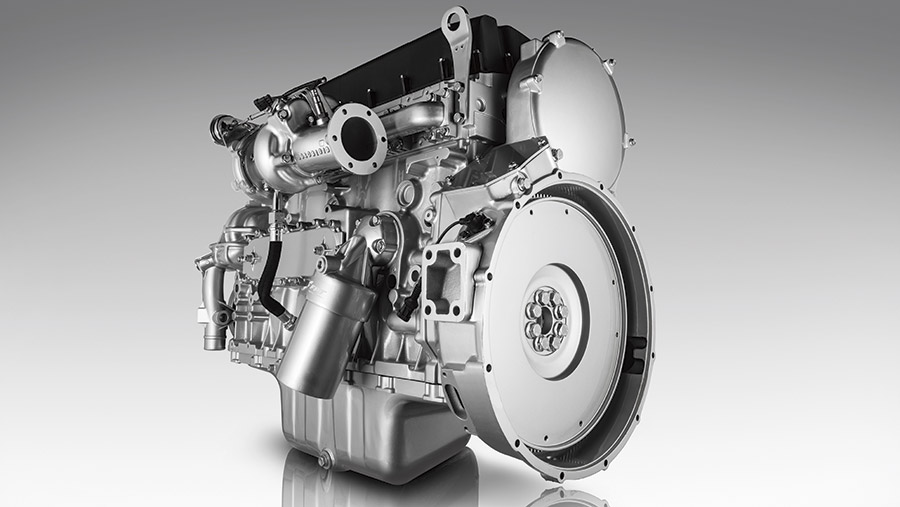
FPT Industrial Cursor 9 diesel, as used in Claas Axion 900 Series tractors
The heavy diesel engines unit of CNH Industrial – manufacturer of Case IH and New Holland farm tractors, telehandlers and harvesters – is winning increased OEM sales on top of its in-house customers.
Almost half of the 606,700 units produced in 2017 were taken by CNH units, with agricultural equipment accounting for 17% (47,400 units).
The other 54% went to customers such as Argo Tractors with 110-310hp engines for Landini and McCormick models, and Claas with 75-445hp engines for the Elios 200 and Axion 800 and 900 tractor ranges, plus Dieci and Merlo, and Agrifac for its Condor sprayer.
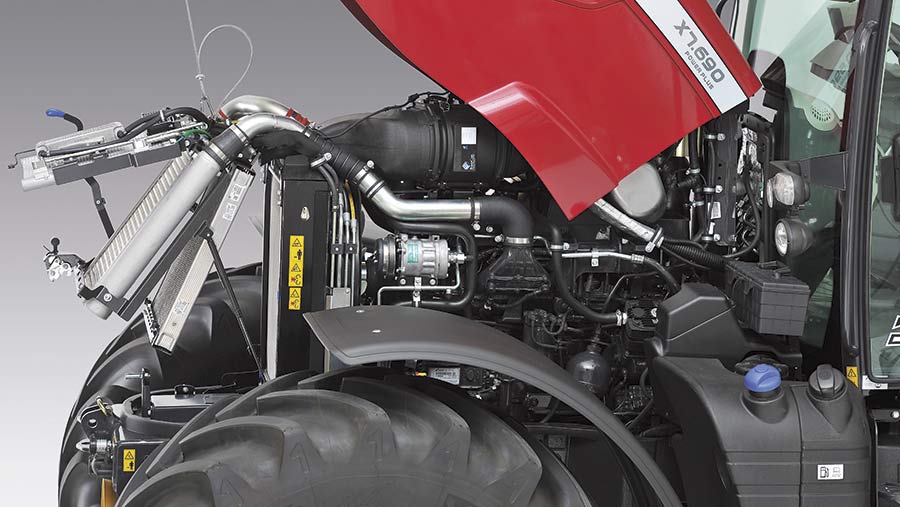
Argo Tractors is an OEM customer of FPT Industrial for engines such as this 206/225hp NEF6.7 six-cylinder
The current business was formed from the diesel engine operations of Iveco Trucks plus other elements of Fiat Group powertrain operations, brought together under the CNH Industrial umbrella.
The company makes 3.4-litre to 6.7-litre engines in Italy and the large-capacity Cursor and new V20 engines in France. FPT also makes engines in Argentina, Brazil and China.
JCB Power Systems
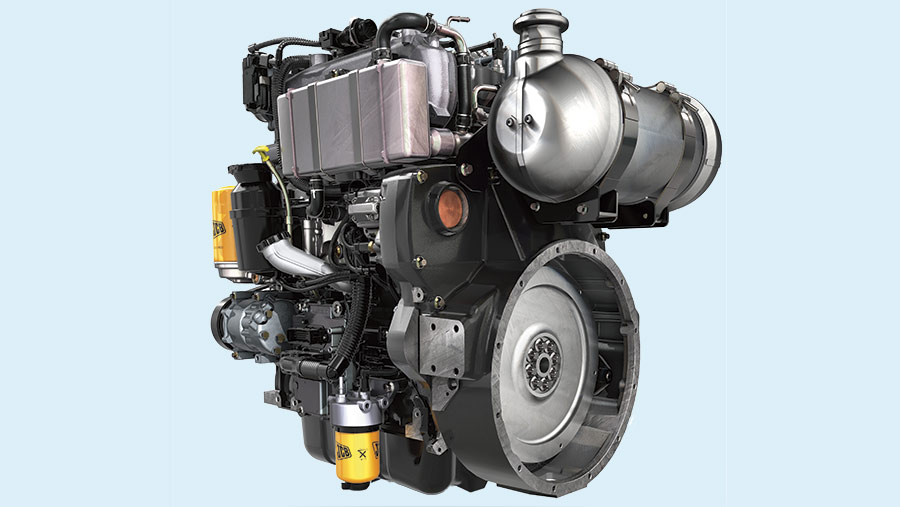
JCB Eco Max is built in 4.4-litre and 4.8-litre versions for telehandlers and backhoe loaders
With 350,000 mainly four-cylinder DieselMax and EcoMax units under its belt in the 10 years to 2015, the JCB Power Systems operation at Foston, near Derby, now powers most of the group’s light construction and farm handlers with 4.4-litre and 4.8-litre engines up to 173hp.
Among OEMs, Briggs Irrigation uses JCB power for pump sets. Italian firm Mazzotti does likewise for smaller versions of its own sprayers and the Vicon iXdrive.
JCB does make a six-pot engine – but only for lower-emissions regulated markets; and engines are built at its Indian construction machinery plant for the local market.
John Deere Power Systems
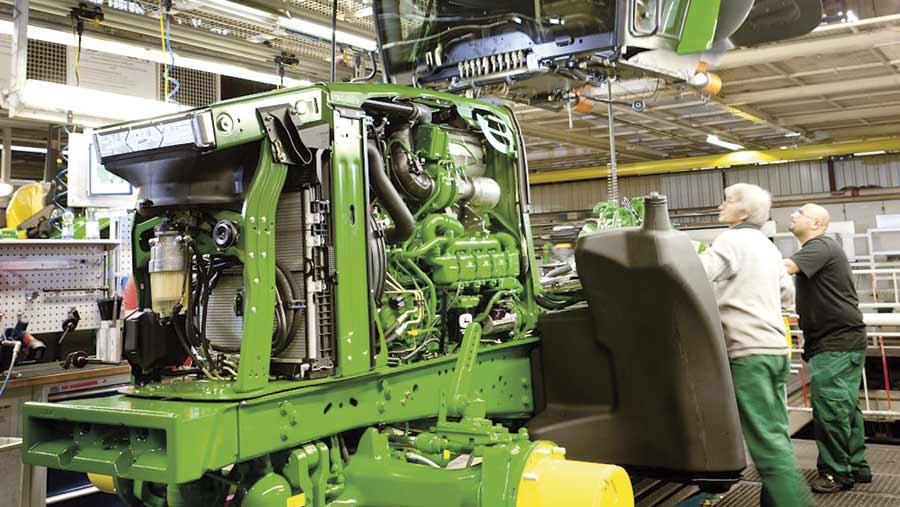
John Deere engines built in France and the USA power the majority of John Deere tractors
Diesel engine manufacturing is a major enterprise for John Deere, given that almost its entire range is powered in-house.
There are plants in Saran near Orleans, France, and at Waterloo, USA, feeding tractor, combine and forage harvester production, and also winning some OEM business.
Claas retains Deere engines for the Arion 500 and 600 tractors built in France; Bateman Engineering and Multidrive are customers for their UK-built self-propelled sprayers; and Kuhn is among feed-mixer manufacturers using Deere power.
A new 13.6-litre engine with up to 684hp could power some of Deere’s most powerful machines from 2020.
Kohler
Still best known for small-capacity petrol engines, the US manufacturer moved into diesels with the 2007 acquisition of Italian engine maker Lombardini and subsequently introduced its first heavy-duty diesel.
Among the first customers for the 3.4-litre KDI was JCB for small wheel loaders and telehandlers. The first tractor application is the new Arbos 5000 Series being built by China’s Lovol Group subsidiary in Italy.
Kubota
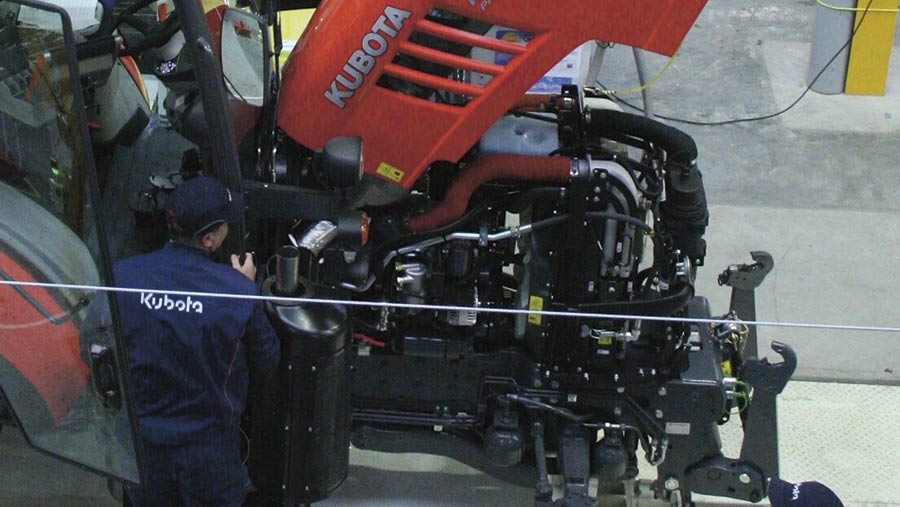
Kubota uses its own four-cylinder engines for all tractors produced in Japan, France and the USA
Small engines are big business for Japan’s leading farm and light construction equipment manufacturer. It claims to be the global market leader for sub-100hp diesels but it also builds larger units – a new four-cylinder series delivering up to 210hp is on its way.
Apart from powering the 95-175hp Kubota tractors sold in the UK, it also counts Avant, Dieci, Manitou, Merlo, Schaffer and Tobroco among its materials handling customers with mainly 50-75hp engines.
Kubota also makes engines in China, Indonesia and Thailand for local consumption.
Liebherr Machines Bulle
 Liebherr 15-litre D9508 V8 powers Krone’s Big X 680 forage harvester with up to 662hp – other versions go to 860hp
Liebherr 15-litre D9508 V8 powers Krone’s Big X 680 forage harvester with up to 662hp – other versions go to 860hp
The heavy diesels division of the construction equipment giant has its foot in the door at Krone, supplying 687-898hp V8 engines for the BiG X 680 to 880 forage harvesters.
A marketing agreement with Deutz should help push more units into the agricultural sector.
MAN Engines
German truck and bus maker MAN has just set up its engines operation as a separate business unit thanks to growing OEM sales, including new business in agriculture.
It has returned to the Fendt range after a long absence with a 12.4-litre unit for the 380-500hp 1000 Vario series. Agco uses the same engine, along with a 15.3-litre unit generating 647hp, for the new Ideal combine.
Claas and Krone use MAN for their most powerful forage harvesters, peaking at 1,078hp.
MTU
This division of Rolls-Royce Power Systems, based in Germany, adapts Daimler OM series truck and bus engines for off-highway applications and stamps them with the Mercedes-Benz brand name.
Claas is a big customer, buying 4,000 to 5,000 units a year for most of its Jaguar forage harvesters and Lexion combines, and all Tucano combines and Xerion tractors. MTU engines up to 230hp are slotted into the Spirit, Merlin and new Predator sprayers from Househam.
Krone’s smallest forage harvesters have 490-626hp MTU engines, Grimme uses them exclusively for beet and potato harvesters, and Agrifac’s Holmer unit employs the 15.6-litre at 626hp for the HexxTraxx.
Perkins
The UK manufacturer may no longer list any big-name tractor marques among its customers but Perkins Engines Co does supply a number of smaller makers, including Armatrac and Lindner.
The Peterborough factory has capacity for up to 500,000 engines a year, building the small 400 Series and compact 850 Series (which is derived from an FPT base engine), and the 4/6-cylinder 1100 and 1200 Series engines.
The new-generation Syncro range of 1.7- to 3.6-litre engines is waiting in the wings for compact machinery and potentially a tractor power revival with outputs up to 134hp.
Knight Farm Machinery uses a six-cylinder, 7.1-litre 1206F engine for the Vista 1800 and 2000 series sprayers – as does Mazzotti, the Italian manufacturer behind the Vicon iXdrive, for its three biggest models.
Several Kramer and Weidemann telehandlers and small loaders get Perkins power and the Cat-branded engines in Caterpillar telehandlers are built at the Peterborough facility.
Perkins remains a big engine maker worldwide, with factories in the USA, Brazil and China.
Scania
Pea pickers built by PMC Harvesters in Fakenham, Norfolk, use a 12.7-litre Scania DC13 with 438hp, while the new three-wheel spreading “floater” from parent company Ploeger has the 9.3-litre DC09 with 400hp.
The bigger Scania motor also gets an outing in 500hp form in the DeWulf Kwatro four-row potato harvester.
SDF
The maker of Same, Deutz-Fahr and Lamborghini tractors returned to latest-emissions engine manufacture with the 2.9-litre and 3.9-litre FARMotion design built at its Indian plant.
This is installed in Deutz-Fahr 4E, 5D and 5G tractors, and equivalent Same models, and in the Claas Atos 200 and 300 supplied by SDF.
Sonalika
The Indian manufacturer of tractors up to 90hp carrying the Solis brand in Europe are powered by in-house engines assembled at the tractor plant.
TMTL Engines
This is the engines manufacturing unit of Tractors and Farm Equipment, maker of TAFE tractors in India, including the 36-60hp models sold in the UK.
Volvo Penta
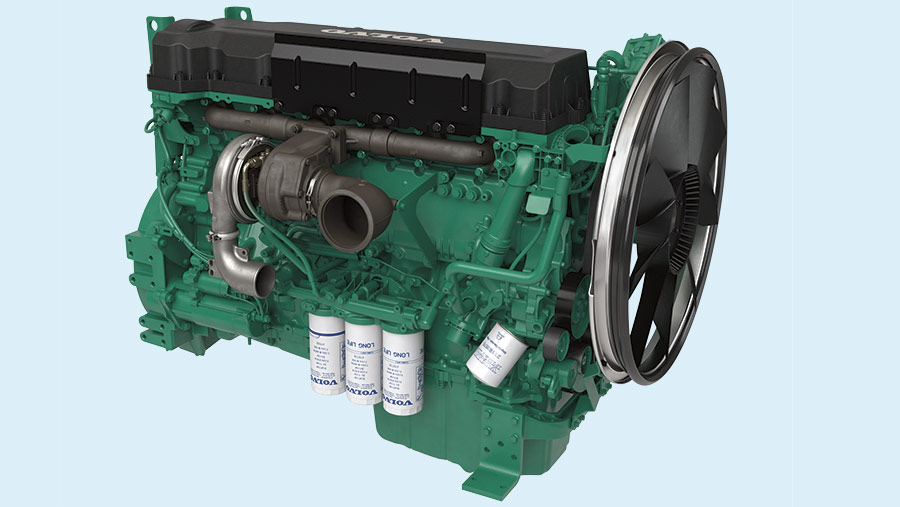
The 13-litre Volvo Penta D13 (pictured in commercial vehicle guise) powers Mastenbroek drainage trenchers and Agrifac beet harvesters
Mastenbroek drainage trenchers and tracked backfilling vehicles are among the machines powered by Volvo Penta 5-litre, 8-litre and 13-litre diesels with outputs up to 400hp from the Swedish truck, bus and construction machinery maker’s engines unit.
A 13-litre unit developing 469hp also nestles under the hood of the AVR Puma 3 potato harvester; the same unit is used by Agrifac in its Holmer Exxact sugar beet harvesters with outputs of 469hp and 612hp.
Four-cylinder Volvo Penta engines power the Kverneland Siloking feed mixers.
Yanmar
The company’s Biwa plant in Japan specialises in compact three- and four-cylinder diesels up to 100hp. In 2015 it reached the five million units milestone, 20 years after opening.
Applications for the TNV Series include one or two small telehandlers in the Dieci, Faresin, Kramer and Wiedemann ranges, all bar one of the Italian MultiOne loaders and telescopics, and Landini and McCormick compact tractors, as well as Yanmar’s own.
Zetor
Despite low production volumes of about 3,200 tractors a year, Zetor continues to make its own 4.15-litre, four-cylinder engines for the 78-147hp Proxima and Forterra models, and for some OEM sales.

